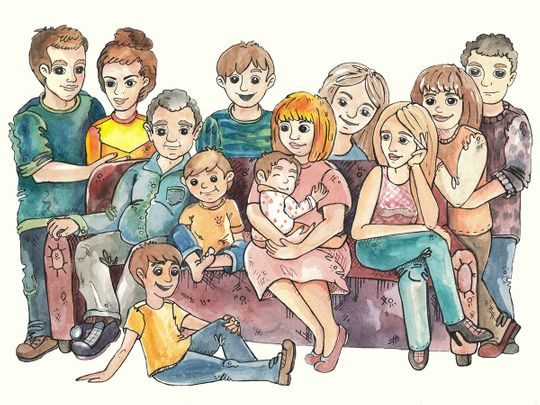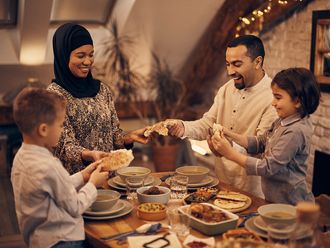
“I’m an only child and when I got married, you know, I figured I’d have one or two kids,” says American expat Chaiya Umm Rashid Brown, who is currently pregnant with her 20th.
There’s always a rumble in the house – conversations scatter silences, laughter jets across rooms in quick bursts, a toy squeaks underfoot, a child squeals and in the distance there’s the patter of feet. “Sixteen of my 19 children still live at home,” she explains.
On the day we speak, Abu Dhabi-based Chaiya is at her organised best, deputing one child to teach another, deploying a second to help a third as she walks into an unemployed – and therefore quiet – room for a chat.
ALSO READ
- Safer Internet Day 2022: How to keep your child safe in the metaverse
- I winged it in my first pregnancy. Here’s why I took a birth course the second time around
- Meeting my IVF baby: ‘I was told I was too fat to have a child,’ says mum
- UAE weight loss: 'How I lost almost 15kg in two months after giving birth'
Chaiya, who is 45 years old, has two sets of twins and she says mothering twins after 14 singletons was like starting all over again. “Even though my first set of twins were my 15th and 16th baby, because they were twins it was like starting from scratch. You had to learn to maneuver two babies at the same time.
A shawl of worry
“I had a normal pregnancy – morning sickness, etc. – but none of that stood out. What stood out was the worry. I think every mother from the time she finds out she is pregnant there’s an automatic worry. But then when you find out twins – this was my first twin pregnancy and I came home and started Googling – there’s all this scary information and initially, you don’t know if they are dichorionic or share a placenta or anything like that. So it’s just like fear and panic … fortunately, it was complication free. You just get extremely tired, because it’s a big demand on your body. My body already knows how to be pregnant but it didn’t know how to be pregnant with two children.”
• Monozygotic versus dizygotic: Monozygotic twins arise from the same zygote, the medical term for a fertilized egg. The zygote splits into two, creating genetically identical twins. Dizygotic twins come from two separate eggs and are not identical — they are no more genetically similar than other siblings.
• Dichorionic versus monochorionic: “Chorion” refers to the placenta. Some twins share a placenta, while others do not. Twins that share one placenta are monochorionic, while those that have separate placentas are dichorionic.
• Monoamniotic versus diamniotic: These terms describe whether twin fetuses share an amniotic sac or have an individual sac.
The type of twin pregnancy can influence the risk of complications.
Source: Medical News Today
Then came the labour. Chaiya, a practising post-natal doula, knew she wanted a vaginal delivery, but was worried about whether it was possible.
“I discussed it with my doctor and she said as long as the first baby’s head was down, we could try for a vaginal birth and if anything were to happen, there was a chance I’d have to have a C-section. If that was the case, they would rush me to the theatre and then … so she asked me if I would agree to have an epidural because if something were to happen, it wouldn’t be a rush to get an epidural in. So I agreed.
“The day of my induction, I drove to the hospital, got out of the car and my water actually broke on its own; they were coming one way or the other. Baby A was born head first and baby B was the smaller baby [who was breech] and when the time came, they just told me to push. I was expecting from all the things that we had talked about and all the things I had read that they would actually try to turn her but they didn’t, they just told me to go ahead and push. I thought at that time that having a breech baby was unheard of, but they told me to push and I did, and I had the baby.”
• Bottom first or feet first (breech position)
• Lying sideways (transverse position)
Breech babies account for about 3 per cent to 4 per cent of all full-term pregnancies.
Source: NHS, Cleveland Clinic
These babies were the Browns’ best kept secret – not even the kids knew, says Chaiya. “We actually kept it a secret the entire time. I didn’t tell my mum or parents. My other kids found out when we walked home. I came upstairs with one baby and they were all ooing and aaing over the baby and then a few minutes later, my husband comes up with the second baby and they are like, ‘what?’ Even though I was huge, I guess they are so used to seeing me pregnant that it didn’t dawn on any of them,” she laughs.
The first six months passed by in a blur, she says. “I would be lying if I said I wasn’t overwhelmed. I exclusively breastfed them, so you know, I had to learn how to feed two babies because they don’t pick and choose what time they want to eat; sometimes it was one of them, sometimes it was both of them, sometimes one wants to feed for two hours straight and the other one wants to sleep. Then you get one to sleep and the other wakes up.
“My older girls were such a help – I would just call them and say, ‘Come and take them, I just need to sleep’. My husband as well – we would tag team – I would hold one and feed one and he’d keep the other one quiet while I put one to sleep, then he’d pass me the other one. He also would help me eat sometimes when both my hands were full, you know, because I’d feed both together. The first six months were a blur because you are in this constant state of sleep deprivation and trying to manage and maintain. I think once you cross the first six months and they start eating solids, it’s a lot easier.”
When Chaiya got pregnant with her second set of twins, she says, “I was confident – you know, I’d been there, done that.”
She delivered two healthy babies – a boy and girl – two years ago.
Parenting over the years
Chaiya, whose oldest son is 28 years old, mulls over her parenting lessons.
1. Tailoring parenting to the child. She explains: “When you are a young parent, you worry differently. You are in a hurry, you want your baby to sit up fast and walk fast and potty train fast and I think first-time mums have this imaginary scene of what they think parenthood is going to look like, what they think childhood development will look like, and then you realise that those pressures and constraints that you put on yourself are just not necessary.
“My first child was potty trained by his first birthday. And at that time I was pregnant with my daughter. Now, my baby twins, they just turned two, they show no interest in potty training and I have no interest in chasing them around with a potty. I’ve learned that the cost of pampers is not worth the aggravation of trying to potty train someone who isn’t ready.”
2. Developing patience. “I’m much more patient – I’m sure my older children will tell you I let my younger kids get away with things that they would never have gotten away with,” she laughs.
3. Different generations, different strategies. “The generations have changed – my oldest children didn’t have technology and cell phones and internet, and all those distractions and with those distractions come a different behaviour so you have to adjust and you have to figure out okay, at what age am I going to let my kids have access to these things and how much. It’s just a different upbringing.”
4. Defining fixed and flexible rules. “There are certain values that you try to teach them. You have to pick and choose your battles – certain things are non-negotiable – when you reach a certain age you have to pray, take care of your hygiene, education. And there’s things as a parent we all want, but kids come with their own personalities so you learn how to be more flexible with a lot of things, not sweat the small stuff. I’ve learnt to let them have more freedom to express themselves and talk to me,” she says.
5. Managing physical fights. “As siblings, from time to time they fight, it’s inevitable. But if it’s a case of one person hits another, they know it’s a house rule to bring it to someone older.”
6. Learning diplomacy. “There’s lots of talking - you have to be so diplomatic, you have to hear this person’s side, you have to hear that person’s side, you have to determine how you are going to handle the situation,” she adds.
Managing logistics
It seems overwhelming, the idea that one would need to cook for 18 people every day – three meals with varying palettes and appetites, but Chaiya says it’s something the family has grown into. “It didn’t happen overnight, so many people in the house, it was a gradual shift. Today, my pots are the biggest pots that I could buy in the market that fit on my stove. Yes, it’s a lot of food [that we cook] but because it didn’t happen overnight, it was a gradual thing, it was easy to adapt,” she explains.
As for holidays, “We go over to Ras Al Khaimah a lot,” she says, adding that they haven’t travelled out of the UAE together yet.
The home is abuzz in anticipation for its latest addition; laughter punctuates the silences – it’s business as usual at the Brown house.
Share your parenting journey with us at parenting@gulfnews.com








